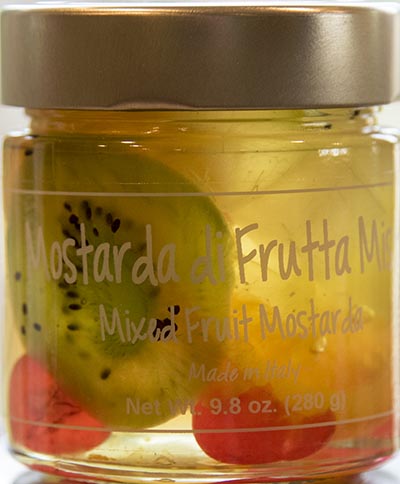Amid the endless jams, honeys, pickled fruits, syrups, crackers and other accompaniments for cheese at last week’s Fancy Food Show in San Francisco, these glamorous Italian mustard fruits (mostarda) stood out. Aren’t they lovely? If you are assembling a cheese board for a special occasion, consider investing in a jar. (They’re not cheap.) Or take a jar to a cheese enthusiast when you’re invited to dinner.
I’ve been smitten with mostarda since a trip to the northern Italian region of Lombardy a few years ago. That’s home base for this condiment, an ancient way of preserving fruit in thick sugar syrup. What makes mostarda so compelling compared to candied fruit is the pungent mustard oil it contains. This is not the mild mustard oil common in Indian cooking, which is pressed from the seed. The oil used in mostarda is a distillate, and it’s a powerful irritant. Workers suit up with goggles and gloves when they add it. In Italy, if you want to make mostarda, you visit a pharmacy and tell the clerk how many drops you want (10 per kilo of fruit). It’s not legal for sale here.
I bought some at a pharmacy in Mantua, and the white-jacketed clerk carefully deposited my 50 drops into a tiny vial. I encased the vial in several layers of bubble wrap, tucked it into my cosmetic bag and buried the bag in my suitcase between layers of clothing. That was dumb. By the time I got home, my wardrobe reeked of mustard. Honestly, I didn’t realize it was a hazmat that never should have been allowed on the plane. According to Rolando Beramendi, the importer of the mostarda pictured here, I should still be in the slammer in Newark.
Like everything in Italy, mostarda varies by region. In Modena and Cremona, they use mixed fruit, preserved whole. In Venice, cooks used a mixed-fruit puree. Mantua grandmas make their mostarda with sliced fruit of a single type. The mustard oil is volatile, so once you open a jar, the pungency dissipates. Recap tightly after using, and finish it off within a couple of weeks.
Available at the Pasta Shop in Oakland and Berkeley, and online at Market Hall Foods , the line includes mixed-fruit, fig and clementine varieties ($22/280 g). Serve mostarda with robust cow’s milk cheeses like Taleggio, Gorgonzola, Fontina Val d’Aosta and Parmigiano Reggiano or with aged sheep’s milk cheeses like Manchego and Pecorino Ginepro. In Italy, I had it dolloped on saffron risotto, and that was memorable, too.
Shaker Heights
Every cheese can’t be a perfect 10. When Oregon’s Rogue Creamery finds wheels that don’t quite measure up, the creamery sends them to a processor who dries, powders and packs them in a shaker jar. Rogue introduced Blue Heaven about three years ago, and the product has succeeded beyond imagining. A popcorn manufacturer uses it, as does a potato-chip maker. A little rice powder prevents clumping, but otherwise, it’s just blue cheese. Shake it over a salad, a steak, roasted vegetables or pasta. Or melt it in the butter you drizzle on popcorn. Available at Whole Foods.
Correction: Last week, in the feature on Bleu des Causses, I listed the Wedge in Sacramento as a source. The Wedge Cheese Shop is in Reno, not Sacramento. The Pasta Shop also carries Bleu des Causses.




